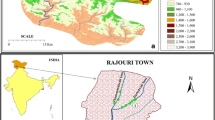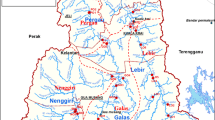Abstract
A pattern of water quality affected by the input regime and site specification is one of the most important issues in water supply resources and demand management. The present study aims to assess the water quality of Latyan dam, the important reservoir that supplies drinking water of Tehran, the capital city of Iran. Monthly water sampling was performed at four depths of the dam. The physical and chemical properties of water including temperature, pH, turbidity, total dissolved solids (TDS), electrical conductivity (EC), hardness, as well as Ca2+, Mg2+, Na+, K+, Cl−, SO42−, silica, ammonium, nitrate, nitrite, and total phosphorus (TP) concentration, were monitored from May 2014 to January 2017. The results of statistical analysis indicated that the quality of water in the dam was affected by the depth in view of five variables of EC, pH, turbidity, SO42−, and TP (p ˂ 0.05). Moreover, it was determined that ten out of 17 variables including EC, turbidity, TDS, Ca2+, K, Cl−, SO42−, silica, nitrate, and TP were statistically significant (p ˂ 0.05) based on seasonal variation analyses. Comparing the mean values, it could be concluded that EC, TDS, Ca2+, K+, Cl−, and SO42− were slightly higher during the winter probably owing to the diluting effects of seasonal precipitation. Nutrient-like distribution, nitrate, and TP, as well as silica, were much higher during the spring representing a high-diatoms activity and eutrophication. Turbidity was higher in the fall compared to the other seasons, which also demonstrated rainfall effects. Evaluation of the aggressiveness index (AI) suggests that water is moderately corrosive, and noncorrosive in the winter compared to other seasons. Moreover, according to the findings of this research and their comparison with the national and international water quality guidelines/standards, it could be said that the water quality of Latyan dam during the study period was acceptable and thus it was usable as a drinking water supply. However, due to the changes occurred in nitrate and phosphorus and extensive development of eutrophication problem, accurate and continuous evaluation of water quality in this reservoir is deemed necessary.



Similar content being viewed by others
Abbreviations
- ANCOVA:
-
analysis of covariance
- TDS:
-
total dissolved solids
- EC:
-
electrical conductivity
- Ca2+ :
-
calcium
- Mg2+ :
-
magnesium
- K:
-
potassium
- Cl:
-
chloride
- SO4 2− :
-
sulfate
- SiO2 :
-
silicon dioxide, also known as silica
- NH4 +-N:
-
ammonia nitrogen
- NO3-N:
-
nitrate ion as nitrogen
- NO2-N:
-
nitrite ion as nitrogen
- TP:
-
total phosphorus
- EDTA:
-
ethylene diamine tetraacetic acid
- N:
-
nitrogen
- USA:
-
United State of America
- QQ plots:
-
the quantile-quantile plot
- p :
-
value
- μs/cm:
-
micro-Siemens/cm
- mg/L:
-
milligram per liter
- CaCO3 :
-
calcium carbonate
- NTU:
-
nephelometric turbidity units
- mg P/L:
-
milligram of phosphorus per liter
- CV:
-
coefficient of variation
References
Akbarzadeh A, Jamshidi S, Vakhshouri M (2015) Nutrient uptake rate and removal efficiency of Vetiveria zizanioides in contaminated waters. Pollution 1(1):1–8
Alberto WD, del Pilar DM, Valeria AM, Fabiana PS, Cecilia HA, de los Ángeles BM (2001) Pattern recognition techniques for the evaluation of spatial and temporal variations in water quality. A case study:: Suquía River Basin (Córdoba–Argentina). Water Res 35(12):2881–2894
APHA WEAPHA (2017) Standard methods for the examination of water and wastewater, 23rd edn. American Public Health Association (APHA), Washington
Atinkpahoun CN, Le ND, Pontvianne S, Poirot H, Leclerc J-P, Pons M-N, Soclo HH (2018) Population mobility and urban wastewater dynamics. Sci Total Environ 622-623:1431–1437
Boran M, Sivri N (2001) Determination the nutrient and suspended solid mater loads of Solaklı and Sürmene River (Trabzon, Türkiye). Ege J Fish Aquat Sci 18(3):343–348
Boyacioglu H (2010) Detection of seasonal variations in surface water quality using discriminant analysis. Environ Monit Assess 162(1):15–20
Brahman KD, Kazi TG, Afridi HI, Naseem S, Arain SS, Ullah N (2013) Evaluation of high levels of fluoride, arsenic species and other physicochemical parameters in underground water of two sub districts of Tharparkar, Pakistan: a multivariate study. Water Res 47(3):1005–1020
Chapman DV (1996) Water quality assessments: a guide to the use of biota, sediments and water in environmental monitoring (Second Edition). World Health Organization, London
Chowdhury S, Al-Zahrani M (2014) Water quality change in dam reservoir and shallow aquifer: analysis on trend, seasonal variability and data reduction. Environ Monit Assess 186(10):6127–6143
Darko G, Ansah E, Faanu A, Azanu D (2017) Natural radioactivity and heavy metal distribution in reservoirs in Ghana. Pollution 3(2):225–241
Ding S, Chen M, Gong M, Fan X, Qin B, Xu H, Gao S, Jin Z, Tsang DCW, Zhang C (2018) Internal phosphorus loading from sediments causes seasonal nitrogen limitation for harmful algal blooms. Sci Total Environ 625(1):872–884
Elci Ş (2008) Effects of thermal stratification and mixing on reservoir water quality. Limnology 9(2):135–142
Guo H, Wang Y (2004) Hydrogeochemical processes in shallow quaternary aquifers from the northern part of the Datong Basin, China. Appl Geochem 19(1):19–27
Ireland-EPA (2001) Parameters of water quality—interpretation and standards. Environmental Protection Agency, Wexford
Karami J, Alimohammadi A, Modabberi S (2012) Analysis of the spatio-temporal patterns of water pollution and source contribution using the MODIS sensor products and multivariate statistical techniques. Journal of Selected Topics in Applied Earth Observations and Remote Sensing 5(4):1243–1255
Karamouz M, Zahraie B, Araghi-Nejhad S, Shahsavari M, Torabi S (2001) An integrated approach to water resources development of the Tehran region in Iran. J Am Water Resour Assoc 37(5):1301–1311
Kazi TG, Arain M, Jamali MK, Jalbani N, Afridi HI, Sarfraz R, Baig J, Shah AQ (2009) Assessment of water quality of polluted lake using multivariate statistical techniques: a case study. Ecotoxicol Environ Saf 72(2):301–309
Kazi TG, Afridi HI, Shah F, Arain SS, Brahman KD, Ali J, Arain MS (2016) Simultaneous determination of silver and other heavy metals in aquatic environment receiving wastewater from industrial area, applying an enrichment method. Arab J Chem 9(1):105–113
Korkanç SY, Kayıkçı S, Korkanç M (2017) Evaluation of spatial and temporal water quality in the Akkaya dam watershed (Niğde, Turkey) and management implications. J Afr Earth Sci 129(May 2017):481–491
Lambrakis N, Antonakos A, Panagopoulos G (2004) The use of multicomponent statistical analysis in hydrogeological environmental research. Water Res 38(7):1862–1872
Lodh R, Paul R, Karmakar B, Das M (2014) Physicochemical studies of water quality with special reference to ancient lakes of Udaipur City, Tripura, India. International Journal of Scientific and Research Publications 4(6):1–9
Potasznik A, Szymczyk S (2015) Magnesium and calcium concentrations in the surface water and bottom deposits of a river-lake system. J Elem 20(3):677–692
Razmkhah H, Abrishamchi A, Torkian A (2010) Evaluation of spatial and temporal variation in water quality by pattern recognition techniques: a case study on Jajrood River (Tehran, Iran). J Environ Manag 91(4):852–860
Saadatpour M, Afshar A, Edinger JE (2017) Meta-model assisted 2d hydrodynamic and thermal simulation model (ce-qual-w2) in deriving optimal reservoir operational strategy in selective withdrawal scheme. Water Resour Manag 31(9):2729–2744
Sawyer CN, McCarty PL, Parkin GF (2003) Chemistry for environmental engineering and science, 5th edn. McGraw-Hill, New York, pp 559–560
Shi X, Wang Y, Jiao JJ, Zhong J, Wen H, Dong R (2018) Assessing major factors affecting shallow groundwater geochemical evolution in a highly urbanized coastal area of Shenzhen City, China. J Geochem Explor 184(part A):17–27
Shrestha S, Kazama F (2007) Assessment of surface water quality using multivariate statistical techniques: a case study of the Fuji river basin, Japan. Environ Model Softw 22(4):464–475
Strobl RO, Robillard PD (2008) Network design for water quality monitoring of surface freshwaters: a review. J Environ Manag 87(4):639–648
Tajziehchi S (2014a) A critical look at social impact evaluation of dam construction by revised SIMPACTS software-a case study of Alborz dam in Northern Iran. International Journal of Environmental Research 8(2):329–334
Tajziehchi S (2014b) Development of new model for computation of external costs of hydropower dams. Int J Sustain Dev 7(4):109–120
Unlu A, Coban F, Tunc MS (2008) Investigation of Lake Hazar water quality according to physical and inorganic chemical parameters. J Fac Eng Archit Gazi Univ 23(1):119–127
Varol M, Gökot B, Bekleyen A, Şen B (2012) Spatial and temporal variations in surface water quality of the dam reservoirs in the Tigris River basin, Turkey. Catena 92(1):11–21
Wei C, Gao C, Han D, Zhao W, Lin Q, Wang G (2017) Spatial and temporal variations of water quality in Songhua River from 2006 to 2015: implication for regional ecological health and food safety. Sustainability 9(1502):1–13
WHO (2004) Guidelines for drinking-water quality: recommendations (Vol 1), 3rd edn. Switzerland, World Health Organization, Geneva
Yang K, Yu Z, Luo Y, Yang Y, Zhao L, Zhou X (2018) Spatial and temporal variations in the relationship between lake water surface temperatures and water quality - a case study of Dianchi Lake. Sci Total Environ 624(1):859–871
Acknowledgments
The authors also are grateful to Water and Wastewater Co. and Iran Department of Environment (DoE) for help in sampling and analyzing samples.
Funding information
This work was related to a Ph.D. thesis and was funded by a grant number of 8656 from the school of health, Shahid Beheshti University of Medical Sciences, Tehran, Iran.
Author information
Authors and Affiliations
Corresponding author
Additional information
Responsible editor: Philippe Garrigues
Electronic supplementary material
ESM 1
(DOCX 21 kb)
Rights and permissions
About this article
Cite this article
Mohseni-Bandpei, A., Motesaddi, S., Eslamizadeh, M. et al. Water quality assessment of the most important dam (Latyan dam) in Tehran, Iran. Environ Sci Pollut Res 25, 29227–29239 (2018). https://doi.org/10.1007/s11356-018-2865-6
Received:
Accepted:
Published:
Issue Date:
DOI: https://doi.org/10.1007/s11356-018-2865-6




